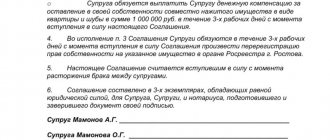The documents necessary for the division of property are collected by the spouses, regardless of who initiates the termination of the marriage. In addition to official documents, unofficial evidence is used (explanations of witnesses, recordings of conversations and correspondence). For some types of documents, it is sufficient to provide copies certified by a personal signature, while others require notarized approval. The final decision of the court when dividing personal and common property depends on the completeness of the evidence presented.
What other documents are needed?
The claim for division of property must be accompanied by documents that confirm or explain the circumstances set out in the text of the application. The following basic documents must be attached:
- general passport;
- marriage certificate;
- certificate of divorce, if it is dissolved;
- children's birth certificates.
For the division of real estate the following are provided:
- certificate of ownership or extract from the Unified State Register of Real Estate (from 2017);
- technical documentation;
- a document providing the basis for the emergence of ownership rights - a purchase and sale agreement, deed of gift, certificate of inheritance, etc.;
- an extract from the house register or house register, if we are talking about a house.
For car section:
- vehicle passport;
- vehicle registration certificate;
- certificate of ownership of the vehicle.
If household appliances, furniture or jewelry are divided, then the following shall be attached to the claim:
- cash receipts;
- warranty cards;
- other documents related to the objects of the section.
If the loan is divided, you must provide:
- loan agreement;
- cash receipt orders;
- payment documents confirming the fact of transfer of loan funds.
If the business is divided, the following are provided:
- company registration certificate;
- articles of association;
- constituent documents;
- financial statements.
When the plaintiff or defendant for some reason cannot be present in court and participate in the court hearing, a proxy is sent. It must have a power of attorney certified by a notary.
Filing an appeal
If one of the parties does not agree with the decision, then before the act comes into force, it can file an appeal. An appeal against a court decision is drawn up in the same way as a statement of claim - it states:
- Name of the court to which the appeal is made.
- Information about the parties (both the plaintiff and the defendant - full name, residential addresses, contact phone numbers).
- Information about the decision against which the complaint is being made.
- Statement of reasons why the decision should be reversed.
Download an appeal against a court decision (sample/form)
The appeal is submitted to the court that made the decision, but is addressed to a higher judicial authority (for a district/city court, this is a regional court). Staff members of the court that made the decision, in turn, prepare the case and submit it, along with the complaint, to a higher authority. Representatives of a higher judicial body accept documents and call representatives of the parties to the process. If, during the consideration of the appeal, the judge considers that there are grounds for reversal, the decision will be canceled and the case will be remanded for review.
Read: How to Seize Property During Divorce
Consideration of a claim in court
After the claim has been submitted to the judicial authority, it is submitted to a judge. The judge, in turn, reviews the documentation and then decides what actions to take:
- Leave the application without progress until the shortcomings are eliminated (if a violation of the norms established by the Code of Civil Procedure of the Russian Federation is revealed).
- Return the claim (if there are grounds specified in).
- Accept the claim.
If the judge decides to accept the claim, the next step will be to issue a ruling. After acceptance, the judge’s staff sends summonses and copies of the ruling to the parties, and the defendant also additionally receives a copy of the claim. In addition, citizens can be notified not only by summons, but also by SMS messages or telephone messages.
At the appointed time, the parties must appear before the court and take part in the process.
Also, if desired, both the plaintiff and the defendant can involve representatives (as a rule, these are specialists from attorneys or law firms). When choosing a truly competent specialist, a situation that seems hopeless at first glance can change dramatically.
As part of their participation in the process, both the plaintiff and the defendant (or their representatives) will express their position and present arguments in their favor, after which the judge will make a decision regarding both the dissolution of the family union and the division of jointly acquired property.
Property division options
The division of jointly acquired property between former spouses can be done in different ways. First of all, the parties must make efforts to peacefully resolve this issue . This can be done in two ways:
- draw up an agreement on the division of common property;
- conclude a marriage contract.
If the divorcing couple has not found a compromise solution, and the conflict situation that has arisen in connection with the division of property flares up more and more every day, then the only option to determine the share of the property due to each spouse is court proceedings .
What documents are needed for the division of property during a divorce?
First of all, you should prepare a statement of claim. It must be drawn up in accordance with the requirements of civil procedural legislation, otherwise it will not be accepted by the court and returned to the plaintiff.
It must be said that a claim for division of property can be filed separately from a claim for divorce - before or after the dissolution of the marriage. But it is possible to simultaneously include in one statement of claim a demand for division of property and a demand for divorce.
So, the statement of claim for division of property contains the following information:
- Name of the court;
- Information about the plaintiff and defendant (full name, residential address, passport details);
- Cost of claim;
- Information about the time and place of registration and/or divorce (with links to the marriage/divorce certificate);
- Presence/absence of a marriage contract;
- Information about the presence of common minor children (with links to the birth certificate);
- Information about jointly acquired property (with links to title, valuation and other documents);
- Justification of claims (with references to family law norms);
- Claims for divorce, division of property;
- List of applications;
- Date of filing the claim;
- Signature.
For more information on how to draw up a statement of claim for division of property (), read the article “Claim for divorce and division of property.”
The following documents are attached to the statement of claim:
- A receipt for payment of the state fee, the amount of which is determined based on the price of the claim. For more information about calculating the state duty when filing a claim for division of property, read the article “State duty for the division of property during a divorce in 2020.”
- Passports of the plaintiff and defendant;
- Certificate of registration and/or divorce (or extract from the civil registry office) - confirmation that a man and woman are or have been married, during which all acquired property is jointly acquired.
Note! If during the official marriage the husband and wife did not live together. They had separate households, this should be proven by attaching to the claim, for example, an apartment rental agreement or a certificate from the housing authorities
- Documents of title for joint and personal property (agreement of sale, gift, exchange, investment, equity participation in construction, privatization agreement, certificate of inheritance, receipts, checks, payment orders, bank statements and other documents confirming personal or joint right ownership of property);
- Registration documents (for real estate - an extract from the Unified State Register of Real Estate, for a vehicle - a registration certificate);
- Valuation documents confirming the value of joint property;
- Other documents. As mentioned above, every circumstance that the plaintiff reports to the court must be proven documented.
Where to submit documents
When filing a claim for division of property in 2020, you should apply either to the magistrate’s court or to the city (district) court of general jurisdiction. The first option is suitable for those persons whose claims do not exceed 50 thousand rubles.
The plaintiff has the right to send an application and copies of documents by registered mail. But it is recommended to do this in extreme cases. This is because upon acceptance, shortcomings may be discovered in the documents provided, and during a personal visit they will immediately be pointed out.
If the plaintiff or his official representative goes directly to court, the claim can be filed:
- on a judicial expedition;
- to the court office;
- personally to the judge during the hours designated for receptions of citizens. This option is used when considering cases by a magistrate.
When choosing an authority, you must contact the one located at the defendant’s place of residence.
If this is not possible, then choose a court at the location of the main property that is subject to division (for example, an apartment). Divorce is a serious ordeal for many. Of course, in such a situation, it is difficult to think about dividing property that has been accumulated together for years. But it would be better for all parties not to delay the resolution of this issue. And if a peaceful settlement of the dispute is impossible, then you need to quickly go to court, preferably by at least consulting a lawyer.
The procedure for filing divorce documents in court
An interested party wishing to end a marriage goes through the following stages of the process:
- preparation of necessary documents;
- drawing up a claim (on your own, with the help of a specialized lawyer);
- sending a copy of the petition and attached documents to the defendant (by registered mail, confirming the fact of delivery of a copy of the statement of claim);
- receiving a receipt confirming the filing of the claim;
- transfer of materials to the court (in a convenient way);
- receiving confirmation that the application has been accepted for consideration (in case of personal transfer, an employee of the court office gives the applicant a receipt of the claim);
- waiting to be called to the first meeting.
At this stage, the applicant may face a refusal to accept the application. The law defines the following legal reasons for refusal to consider an application:
- violation of rules of jurisdiction;
- submission of an incomplete package of documents;
- violation of the claim form;
- preparation of an application by an unauthorized person.
Which court should I file my documents in?
The following legal acts deal with the legal regulation of issues of termination of marriage in court:
- Family Code (rights and obligations of participants in a divorce);
- Tax Code (amount of state duty);
- Civil Code (resolution of property issues);
- Civil Procedure Code (procedure for filing a claim, requirements for a petition, jurisdiction);
- Federal Law “On Civil Registry Office” (further transfer of the claim to the civil registry office for the production of a divorce certificate);
- Government Decree No. 15 (peculiarities of termination of a marriage with children and in the presence of a property dispute);
- Federal Law of 2011 “On courts of general jurisdiction” (jurisdiction, procedure for consideration of issues, reasons for refusal to accept a statement of claim).
The task of legislation is to establish universal and fair rules for the protection of violated interests in court for the entire population.
Table No. 1 “Jurisdiction of divorce cases”
| Conditions | District Court | Magistrate's Court |
| Consent of spouses | Unilaterally or by mutual consent | When the partners mutually decide to divorce |
| Joint property | Resolution of material disputes if the value of the claim is above 50 thousand rubles | Division of property with a total value of up to 50 thousand rubles |
| Minor children | There are and are emerging disputes regarding the upbringing and maintenance of a common child | Disputes about children are settled by drawing up a settlement agreement with a notary |
If the magistrate’s court began considering the claim, but a conflict arose between the participants in the process, then the case is transferred for jurisdiction to the nearest district court of general jurisdiction.
The Code of Civil Procedure stipulates that all petitions must be sent for consideration to the court located at the defendant’s residence address. Consideration of the dispute at the plaintiff’s place of residence is possible under the following circumstances:
- the applicant has a young child or is in the care of an incapacitated relative;
- the plaintiff has a disease that prevents him from traveling between cities to resolve the dispute;
- The defendant's residential address is unknown.
Methods for submitting documents
Available methods for submitting an application:
- The most convenient way is for the interested party to personally apply to the court. The citizen brings to the office of the institution the original of the claim and its copy, on which the employee signs and the date of receipt of the statement of claim.
- Involvement in the procedure of a representative acting under a notarized power of attorney. The power of attorney contains the scope of powers of the person involved and the validity period of the permitting documents.
- Russian Post offers clients the opportunity to send valuable letters with a list of attachments. This way you can submit a statement of claim to the court demanding an end to the marriage. Be sure to include a contact phone number in the application to facilitate communication between participants.
- The Internet will not help initiate a legal divorce. Some federal courts have already activated the ability to accept applications by mail. For this purpose, you need to go to the website with a list of existing authorities, select the desired court and familiarize yourself with the email address.
Remote access allows users to submit an application for divorce to the registry office directly or after the relevant court verdict has entered into legal force.
Application processing time
Deadlines established by the Code of Civil Procedure:
- 3 days – from the receipt of the claim until the appointment of the responsible judge;
- 30 days – from the date of appointment of the judge to the first meeting;
- 1-3 months – reconciliation period;
- 1 month – entry into legal force of the final decision;
- 10 days – obtaining a divorce certificate from the civil registry office after the court verdict is passed.
Execution of a court decision
When the decision comes into force, it is subject to execution. If citizens asked to dissolve the marriage and divide property, then after the judicial act enters into force, the former spouses must:
- Contact the judicial authority again and put a stamp and the date of entry into force.
- Contact the civil registry office with a copy of the decision and an application in order to obtain a document confirming the termination of the family union.
- Execute the decision of the court regarding the division of property.
If any of the parties does not comply with the decision of the judicial authority voluntarily, this will be done forcibly. In order to achieve forced execution of a decision made by a judicial authority, you must contact the Federal Bailiff Service and write an application to initiate an individual entrepreneur. Bailiffs, in turn, will initiate enforcement proceedings and implement a set of measures aimed at enforcing the decision.
Division of joint property of spouses in Crimea
All objects of property for which there is no evidence to refute their receipt during marriage as joint property are subject to division on equal terms. The income of the spouses is also divided (among other things, from business, pensions and benefits). At the same time, according to the Family Code, debt obligations are also joint: loans, loans, mortgages.
The following are not subject to division:
- property accepted free of charge as a gift, inheritance or otherwise;
- property acquired before marriage;
- targeted payments (for example, social);
- personal belongings (clothing, personal household items);
- jewelry that is donated to one of the partners;
- penalties, compensation;
- personal contributions of partners (if there is no evidence that the contribution was replenished with the personal funds of the second partner or from the general budget);
- children's property.
Personal property can be included in the list of divided property with the consent of its owner.
Please note: In the marriage contract or in the agreement on the division of marital property, it is necessary to indicate specific characteristics of the property with links to title documents.
When the standard division procedure defined by law does not suit the spouses for some reason, they have the option of concluding a marriage contract. It provides for the conditions for dividing property and determining shares, but it is also possible to prescribe conditions of use and other agreements relating to property. These conditions can come into force both during divorce and during marriage.
A marriage contract can be concluded both before entering into an official marriage and during it (Article 41. RF IC, part 1). The agreement itself is concluded exclusively in writing and is subject to mandatory notarization. Once concluded, the contract governs the relationship of the spouses for the entire period of marriage and does not require re-conclusion.
Employees of IP Lyutov provide advice on possible options for determining the property regime of spouses and assistance in the preparation and collection of documents for submission to the notary, and represent the interests of clients in the notary authorities.
At the same time, the Family Code protects the rights exclusively of those citizens who are officially married. When living in a so-called civil marriage, spouses have the right to enter into agreements on the use of various objects of property and make transactions. However, if you need to get part of a partner’s property, purchased jointly, but registered in one person’s name, going to court will not yield anything.
The division of jointly acquired property of spouses occurs not only during divorce, but also if one of them dies. When determining the list of inherited property, all jointly acquired property is divided first between the spouses, and then the property of the deceased is divided between the first-line heirs. Inheritance of shares and awards, which should be transferred to various associations of citizens, is not possible.
The division of property during a divorce can be:
- by agreement;
- through the court.
The complexity of the procedure can be influenced by various factors, ranging from the wishes of the spouses, ending with issues of the amount of property, the item of property itself (cars, real estate, interior items, other property), its cost, controversial acquisition (for personal funds or jointly), etc. .
The same factors can influence the timing of this process. A lawyer for the division of property from IP Lyutov from Simferopol will help to smooth and emotionally ease your consideration.
To divide property during marriage or divorce, only a notarized division agreement is required. It must indicate:
- an exhaustive list of property;
- its assessment;
- procedure for division and transfer of ownership;
- if necessary, the conditions for transferring something into ownership to a party to the contract;
- other requirements;
- effective date;
- signatures of the parties.
The agreement is concluded voluntarily and cannot infringe on the rights of the child or one of the parties.
If the parties do not come to an agreement on their own, their case is considered in court.
Types of property subject to division
The need to divide property usually appears when it becomes the common property of several citizens, i.e. belongs simultaneously to two or more persons. In the Russian Federation, issues relating to the property of citizens are regulated by Articles 34 of the Civil Code and 256 of the Civil Code. Therefore, all controversial situations regarding the division of property are resolved taking into account the procedure regulated by these articles.
The law defines two types of common property:
| Common shared ownership | Common joint property |
| The owners are assigned specific shares. They have the right to own common property in the specified shared amount. | The right to own a specific property between the owners is not divided into shares; they are its owners together. Such property is formed when citizens marry. By law, all property acquired during marriage becomes joint property. If such property needs to be divided, the shares of each co-owner must first be determined. |
When receiving an inheritance, common shared property usually arises when it is formalized in accordance with the law in the absence of a will, or when the testator includes in a testamentary disposition a condition on the distribution of his property among the heirs in shares.
Expert commentary
Kamensky Yuri
Lawyer
Regardless of the origin of the common property, i.e. it does not matter whether it was formed upon receipt of an inheritance or during the life of spouses together, the procedure for dividing property and preparing the necessary documents for its implementation will be the same and depend on the specifics of each object of division.
List of documentation for the division of property upon termination of a marriage relationship
If citizens decide to dissolve the marriage and, at the same time, divide property, they need to prepare documents. As a rule, the list of required documentation includes:
- Statement of claim.
- Receipt for payment of state duty.
- Certificate of registration of marital relations (original).
- Identity document of the person acting as the plaintiff.
- Birth certificates of children (if they were born during marriage).
- Certificates confirming the income level of the parties.
- Documents for property acquired during marriage, confirming its availability and value.
It is important to note that the above is not an exhaustive list of documentation - citizens, if they wish, can supplement it (the legislator does not impose restrictions in this case)
Statement of claim
The claim is the main document presented when applying to a judicial authority. It can be compiled by citizens independently (for example, based on samples available on the Internet), in addition, it is possible to use the help of lawyers.
The claim can be either typed on a computer or written by hand - the main thing is that all its copies are completely identical.
As a rule, the statement of claim includes the following information:
- The name of the judicial authority to which the appeal is made.
- Information about the parties - the plaintiff and the defendant (full name, residential addresses, contact phone numbers).
- The name of the document (in this case - “statement of claim for divorce and division of property”).
- The date the parties entered into the family union (with reference to the certificate of registration of the marital relationship).
- Information about children born to spouses during the marriage relationship (full name, date of birth).
- The date from which citizens ceased family relationships.
- A list of property that the spouses acquired during the marriage (with a detailed description).
- The value of jointly acquired property.
- A request for dissolution of the family union, as well as for the division of values acquired during marriage.
- List of attached documentation (shown above).
At the end of the statement of claim, the plaintiff's signature and date are placed.
Download the statement of claim for divorce and division of marital property (sample/form)
The statement of claim is drawn up according to the number of persons taking part in the consideration of the case - that is, at least in 2 copies.
Receipt for payment of state duty
Upon divorce and division of property through a judicial authority, the plaintiff will need to pay a state fee. Details for paying the fee can be clarified directly in court. The amount of the duty can be calculated independently - using the “state duty calculator” posted on the department’s website
Payment can be made at any financial institution that provides such services, after which the payer will receive a receipt, which is important to keep
Property documents
If we talk about documents for the property that is the object of division, then in this case, title documentation (for example, an extract from the Unified State Register, sales agreements), as well as receipts and checks will do.
Marriage contract
Unlike an agreement on the division of property, a marriage contract provides not only the conditions for the division of property that the spouses have at the time of its preparation, but also that may be acquired in the future.
In addition, the procedure for dividing property may deviate from the principle of equality, to the point that in the event of the occurrence of certain events stipulated by the contract, all property will be transferred to one of the spouses (for example, adultery of the husband or wife).
The marriage contract is also subject to notarization. Documents confirming the information contained in the marriage contract are similar to those provided when concluding an agreement on the division of property.
The issue of preparing documents for the division of jointly acquired property of spouses is a rather complex process, since each type of divisible property has individual requirements for the attached documentation. That is why, if a citizen is not sure of the correctness of drawing up a statement of claim or the reliability of calculating the value of disputed property, the best option would be to turn to the help of specialists who can professionally and quickly draw up all the necessary papers.
Documents for judicial division of property
If the spouses cannot reach an amicable agreement, they go to court to divide the common values. To do this, the initiator of the rupture draws up a claim and sends it to the authority at the place of the defendant’s own residence or at the address of the location of the disputed real estate. In Art. 132 of the Code of Civil Procedure of the Russian Federation states that supporting documents are attached to the application. These include:
- claim for division of property
- all-Russian passports of spouses;
- copies of marriage and divorce certificates;
- birth certificates of joint children (if any);
- documents confirming the rights of spouses to property (extracts from the Unified State Register of Real Estate, purchase and sale agreements, exchanges, donations, etc.);
- other documents confirming the circumstances referred to by the plaintiff.
Statement of claim for division of property
A receipt for payment of the state duty is attached to the claim. Its size depends on the value of the couple’s joint property. It is determined as a percentage of it according to the rules outlined in Art. 333.19 Tax Code of the Russian Federation.
To determine the value of property, spouses turn to the services of independent appraisers. You cannot do without their help if there is reason to believe that the price of an apartment (car, cottage) has changed in the time that has passed since the purchase (for example, due to repairs or additions). The report of the involved company is attached to the statement of claim.
The list of additional documents attached to the claim depends on the arguments used by the plaintiff. If he indicates that he did not live with his wife, then he provides a lease agreement for another apartment; if he states that he independently repaid the loan for the dacha, then he prepares statements and payment orders certified by the bank. Depending on the situation, a married couple has the right to use witness testimony, photo and video materials, and expert reports.
How is a claim made?
A mandatory document to begin court hearings on the division of property of a married couple is a lawsuit. The rules for writing it are given in Art. 131 Code of Civil Procedure of the Russian Federation. From its provisions it follows that the statement consists of three logical parts:
- Introductory
Contains the name of the court to which the claim is sent, information about the parties to the future proceedings (full names of the spouses, their residential addresses, contact details).
2.Basic
Contains a description of the current situation. Here is a list of common valuables acquired by a married couple, the date of their purchase, and the date of marriage registration. The calculation of the cost of the claim is given, i.e. determination of the amount of monetary claims against the defendant. In the main part, the compiler refers to articles of current legislation and provides arguments in his favor.
3.Final
Contains a specific demand of the plaintiff (for example, to leave the wife an apartment and the husband a dacha). Here is a list of documentation attached to the application.
The claim is certified by the handwritten signature of the author-drafter. According to Art. 132 of the Code of Civil Procedure of the Russian Federation, it is printed in one copy for each participant in the future process. The citizen brings the completed application to the court during a personal visit, delivers it with a lawyer acting under a notarized power of attorney, or sends it in a valuable letter with a list of the attachments.
How does the court divide property?
The court that has received documents from the plaintiff spouse must answer two questions:
- what property of the couple is recognized as joint;
- in what proportions should it be divided?
The category of joint property includes valuables acquired by spouses during the period that has elapsed since the registration of the marriage in the registry office
From the point of view of the law, it does not matter who was the main breadwinner in the family. This section excludes items of personal use, copyrighted works of the husband or wife (for example, books, songs, paintings written by them), assets received as a gift or inheritance from third parties
In Art. 39 of the RF IC states that the court divides property in shares of 50:50. He has the right to deviate from this principle if there are compelling reasons. If one of the spouses wants to receive more than ½ of the acquired assets, he attaches to the claim documents confirming the spouse’s antisocial behavior (for example, a certificate of registration with a drug dispensary, a protocol on an administrative violation committed while drunk) or his own need (for example, the mother of a common child brings a 2-NDFL certificate, which indicates her modest salary).
Based on the results of the proceedings, the court makes a decision, which comes into force 30 days after the date of the hearing. Spouses are given its originals at the court office. If the husband (wife) does not want to give up the valuables due to the other party, the decision is transferred to the bailiffs for forced collection.
How are the shares of each spouse determined when dividing property?
The Family Code sets out a scheme for determining the shares of each spouse. Article 39 states that property during a divorce is divided into 2 equal parts, but exceptions are allowed:
- If the interests of minor children are protected.
- There is a signed contract that specifies other conditions.
Debts are also subject to division in proportion to the shares of each spouse. An experienced lawyer will help you draw up a statement of claim to protect your property interests. This guarantees a successful outcome, and all nuances will be taken into account when dividing property.










